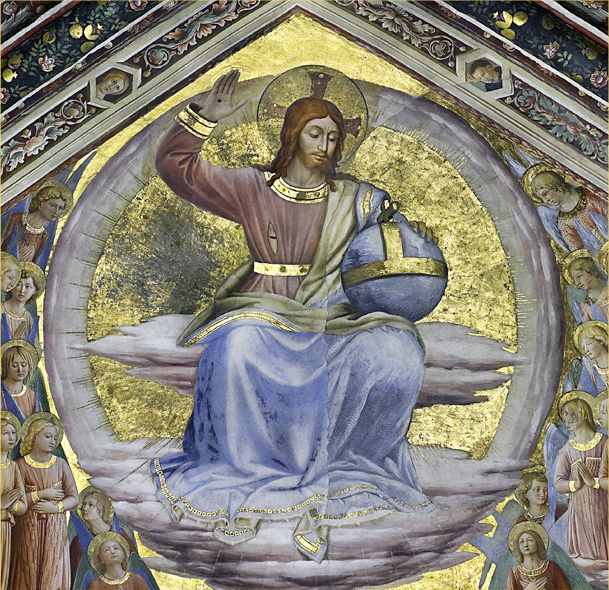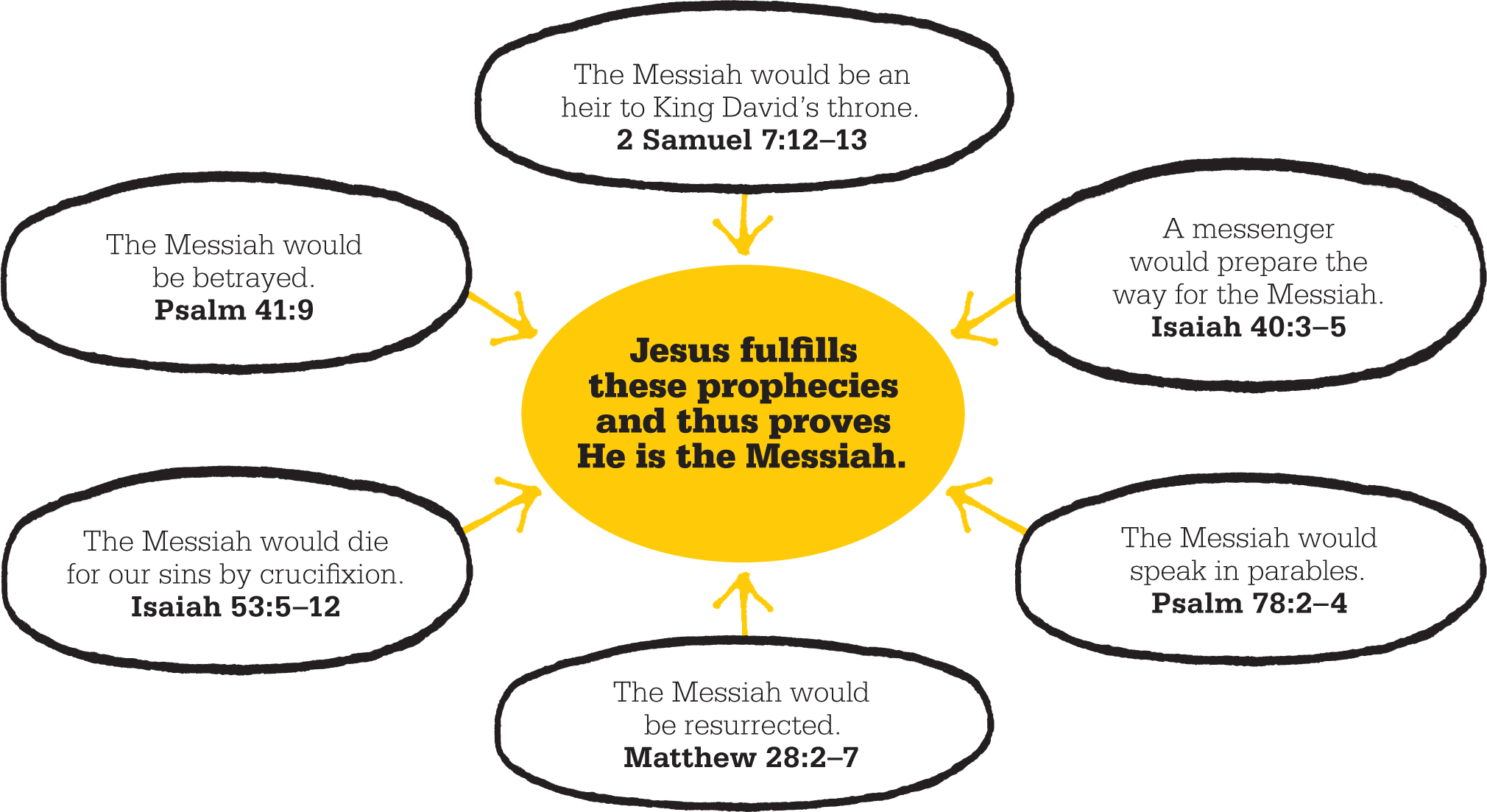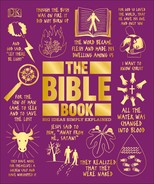
IN BRIEF
John 1:1–18
The Incarnation
c.24–27 CE Roman Palestine
John Author of the fourth Gospel in the New Testament.
The Word John’s title for Jesus, emphasizing His divine nature.
For Christians, Jesus of Nazareth is the central figure in the Bible. Although prophets, priests, and kings have come before Him, none taught as He did, nor provoked such loyalty and hostility. Jesus’s life, teaching, death, and resurrection are the substance of Christian teaching.
Word of God
The Gospel of John is the last of the four Gospels to be written. One of the main concerns in the Apostle John’s New Testament writings, which include the epistles of 1–3 John, is to encourage those who believe in Jesus that He is the Son of God. It begins like Genesis 1 with the creation of the world. Just as Genesis 1 assumes the existence of God, “In the beginning God …” and goes on to assert that this God is the creator, “and God said, ‘Let there be light’,” John opens with, “In the beginning was the Word, and the Word was with God, and the Word was God … All things came into being through Him.” The foundation of all things, according to John, was the Word, who was in some sense God, and yet somehow distinct from God.
In John 1:14–18, the Apostle returns to the connection he made between the divine Word and creation. John declares that “the Word became flesh, and dwelt among us …” and God exhibited His glory as His “one and only” Son.
John the Apostle’s claim that Jesus was also the creator did not arise with his Gospel nor was the realization that Jesus was, and claimed to be, something more than a Galilean carpenter or a preacher a late invention. Jesus’s behavior itself implies divinity. The first three Gospels portray Him acting in ways that parallel God’s interventions in the Old Testament, such as feeding the 5,000 with loaves and fish (God feeds the Israelites in the wilderness) and stilling storms (as God does in Jonah when the prophet runs away to sea).
Matthew, Mark, and Luke’s Gospels also report incidents in which several religious leaders understand Jesus to be claiming divine status. Most famously, the night before His crucifixion, Jesus faces a trial before a large group of religious leaders. They demand to know if He is the Christ, the Son of God. Jesus affirms that He is, saying they will see Him “sitting at the right hand of the Mighty One, and coming on the clouds of heaven” (Matthew 26:64).
The Apostle Paul, preaching across the Roman Empire after Jesus’s death, writes that Jesus is divine. He refers to Jesus as God twice in his letters and calls Jesus “Lord,” a Hebrew term for God. Paul anticipates John’s teaching that all things are created through Jesus (1 Corinthians 8:6) and insists that Jesus possesses every attribute of divinity (Colossians 1:19, 2:9), such as omnipotence, eternality, and omnipresence.

Awaiting the Messiah
The prophet Isaiah had predicted that the Messiah would be born to a virgin and be called “Immanuel” (Isaiah 7:14), meaning “God with us.” In the New Testament, the author of the Gospel of John reports how John the Baptist, proclaiming Jesus’s higher rank, says, “He was before me” (John 1:15). The implication is that Jesus, who was younger than John the Baptist, existed eternally.
The other Gospels report that even during Jesus’s lifetime, people see and hear things about Him that are extraordinary. When Herod hears that magi from the east are visiting the infant Jesus, he sees the child as a threat and asks his chief priests “where the Messiah was to be born” (Matthew 2:4).

St. Simeon

Eight days after His birth, Mary and Joseph present Jesus for circumcision at the Temple in Jerusalem. Luke’s Gospel tells how an elderly priest, Simeon, who was longing for the coming of Israel’s Messiah, is in the Temple courts that day (Luke 2:25–35). God had promised Simeon that he would not die until he had seen the Messiah. Led by the Holy Spirit, Simeon takes the infant Jesus in his arms and blesses Him. In Simeon’s Song, he praises God for keeping His promise, both to him and to Israel. He identifies Jesus as the salvation for both Israel and for the world.
Simeon’s expectation echoed the universal scope expressed by Isaiah, who talks of the Israelites being a “light for the Gentiles” (Isaiah 49:6). Salvation would come first to the Jews, but would not be for them alone. God’s plan was to save people from all nations. The praise in Simeon’s Song anticipates an important theme in Luke’s Gospel and in Acts—the salvation of the wider world.
John’s evidence
The Gospel of John provides the most explicit case for Jesus’s divinity. After healing a man on the Sabbath day, Jesus answers the rabbis’ criticism by equating God’s work with His own, calling God His Father, and making Himself equal with God. In another dispute, Jesus states that “before Abraham was, I AM,” thus making a claim to preexist Abraham (John 8:58). The rabbis understand these words, but deny their truth, and pick up stones to kill Jesus for blasphemy. Later, when pressed to declare if He is the Messiah, Jesus says, “I and the Father are One” (John 10:30), echoing Deuteronomy 6:4—“Hear O Israel, the Lord our God, the Lord is One”—but replacing the second “Lord” with “I and the Father.” The supreme act in support of Jesus’s claim to be divine is His resurrection. After His execution by the Romans for being a rebel, Jesus’s resurrection would have stood as God’s vindication of Jesus’s words and deeds. When Thomas finally sees the resurrected Jesus, he addresses Him as “My Lord and my God” (John 20:28).
“Christ was not … a being half human and half not, like a centaur, but both things at once and both things thoroughly, very man and very God.”
G.K. Chesterton


The incarnation
Jesus of Nazareth is a man who eats and sleeps, yet He also claims to be God. Affirming these two ideas together is the doctrine of the incarnation: the Word becoming flesh. Some early teachers tried to resolve this paradox by saying Christ was fundamentally human, but had been “adopted” as God’s Son. Others, affirming the genuine deity of Jesus, taught that He only “seemed” to be human. Yet others insisted that Jesus could really be God because He was the Father in disguise. Later teachers affirmed the humanity and deity of Jesus, but struggled to find a consistent explanation for how He could be both. In the 5th century some teachers affirmed that Jesus had a human body and soul, but that the divine Word took the place of His human spirit. Others taught that the human and divine had merged in Jesus, and that He was neither purely divine nor human.
In 451 CE, Church leaders at the Council of Chalcedon in Turkey affirmed that Jesus possessed two natures, one divine and the other human, in His one person. Each of these natures was complete, not lacking any attribute proper to being either divine or human. The Chalcedonian Creed became the affirmation of the incarnation. The doctrine of the incarnation arose as a recognition of the validity of Jesus’s claim to be God; an assertion vindicated by His resurrection. Yet it also protected Christianity from the possibility of a fatal internal contradiction. Jesus accepted worship as God from His followers and commanded them to trust in Him for their salvation. If Jesus were not God, then His followers were guilty of idolatry, an offense for which there was no atoning sacrifice under the Law of Moses. But worship of and trust in Jesus would not be idolatry if Jesus were God, and salvation in His name would not be blasphemy.
See also: The Exodus • The Suffering Servant • The Crucifixion • The Empty Tomb • The Coming of Salvation
